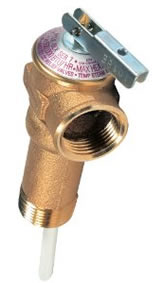- Water smells of sulfur (rotten eggs)
The most common water heater fault associated with a water having a very strong odor is:
- When the sacrificial anode is functioning it creates hydrogen gas which in turn feeds bacteria.
Troubleshooting:
Flush the hot water heater tank. Pour a solution of 1 pint of 3% peroxide to 20 gallons of water into the cold water inlet of the hot water tank. Open the hot water on every faucet to allow the solution to enter the hot water pipes. Turn off each faucet as soon as water flows. Do not run the hot water in the home from any faucet for at least 2 hours to allow enough time for the solution to work.
Note: You do not have to flush the hot water tank or pipes as the peroxide solution is not toxic.
If the flushing combined with the peroxide solution does not remove the smell you can try another fix and that is to replace the current anode with an anode made from a zinc-alloy.
If that does not rectify the problem the hot water tank should be replaced with a unit that has a plastic lining in the tank.
- Water tank makes gurgling noises
The most common water heater fault associated with a gurgling noises coming from the hot water tank is:
- If you hear a gurgling or bubbling sound coming from your hot water tank it is most likely caused by the water boiling due to an excessive amount of sediment in the bottom of the hot water tank. The bottom of the hot water tank is overheating and causing the water to boil.
Troubleshooting:
Flush the hot water heater tank.
- High pitch whining sounds
The most common water heater fault associated with a high pitch whining sounds coming from the hot water tank is:
- A high pitched whining sound is usually caused by a buildup of scale material on the electrical heating elements.
Troubleshooting:
Flush the hot water heater tank.
Remove the upper and lower heating elements and remove the scale that has formed on the elements.
You can replace the current upper and lower heating elements with low-watt density heating elements. These low-watt density heating elements have a larger surface area which makes the transfer of the heat from the elements to the water much more efficient. The low-watt density heating elements develop scale at a much slower rate than standard heating elements.

Figure 8 - T&P relief valve
- Water below base of hot water tank
The most common water heater faults associated with a water below the base of the hot water tank are:
- The most common cause of leaking around the base of the water heater is caused by corrosion of the lower portion of the tank where the base is attached to the side wall.
- Temperature & pressure relief valve, as shown in Figure 8, is leaking.
- Leak in plumbing connection above or beside hot water tank.
Troubleshooting:
Open the temperature and pressure (T&P) relief valve and allow enough water to escape to clean out any debris that may be preventing the valve from closing properly. If the T&P valve is still leaking replace it.
Note: Be careful as the water coming out of the T&P valve can be quite hot.
Check the bottom of the tank, especially around the base for water marks and signs of rust. If water is apparent on the base of the unit or if there are high levels of rust, the hot water heater should be replaced.
